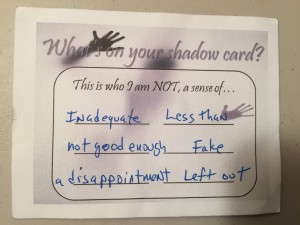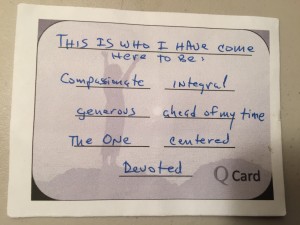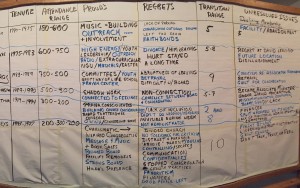“Please have compassion for me when I am being inadequate, less than, not good enough, a fake, a disappointment or left out; because THIS is who I have come here to be: compassionate, integral, generous, ahead of my time, The One, centered, and devoted.”–Gary’s Q Card / Shadow Card

Those who have participated in the Q Process™ Workshop have identified their own limiting beliefs (shadow qualities). In addition, they have identified attributes and qualities that represent their noble self, what we call Q Card qualities–who they that come here to be.

After participants have created their cards, they connect with others and share their card using the structure above. As you can imagine, a profound experience occurs–people experience an authentic heart-opening as they become aware of both the shadow and being attributes each person owns. It becomes a huge “coming out” for the community and the room is filled with compassion, disbelief, recognition (I “see” you), and empowerment as the shadow is brought into the light. So far, over 155 people in our community have had this experience and are using the Q Process™ to integrate limiting beliefs.
Last weekend I facilitated a process similar to the Making Peace with Our Past process called The Genogram Activity. The purpose of this event was to identify unresolved issues associated with our ministry’s rich 102 year history and surface the shadow dynamics underlying pain points (the church’s pain body) within the community.
The story telling process involved documenting each ministerial era–spiritual leader, tenure, attendance range, proud’s, regrets, transition range (stress level), and unresolved issues. Only participants present to a specific era were permitted to provide input for each category (tenure, attendance, etc.). Together, we created a flowchart of legacy events.

The event was pivotal for the participants who gave voice to the conditions that impacted the community deeply especially surrounding wounding experiences, loss, miscommunication, power struggles, and outright abuse. Having the context of the Q Process™, they understood that they took on limiting beliefs about themselves, their spiritual leaders, and Unity headquarters in those moments when they (as a community) related poorly to these triggering circumstances. They discovered more concretely the life patterns that became a part of the ministry’s culture and identity. They saw how each ministerial era inherited the baggage of all of the previous eras. And, while they participated in a Making Peace with Our Past process a decade earlier, they conceded that their unresolved issues and pain points had become a lingering legacy. There had been no integration, no reconciliation, no release, and no healing.
Linking the Genogram Activity with the Q Process™ provides an advantage over the former healing and reconciliation component of the Making Peace with Our Past process in two important ways:
1) Once the shadow qualities have been identified, and the ministry’s Q Card has been formulated, the entire congregation can make a conscious decision to engage organizational issues (triggering moments) as opportunities to integrate past traumas. Next, by taking authentic action consistent with who they have come here to be (Q Card qualities) they are able to overwrite unhealthy patterns of behavior and evolve the culture of the ministry.
In addition, individuals who are burdened by past hurts are able to understand their wounding experiences and the behaviors of “the offenders” each are effects of the disconnect (being who they are NOT–coming from their shadow) as opposed to someone or something against them. And, while the facts of matters are not disputed (a person’s hurt actually happened), the meaning that is taken on shifts from victim to ownership to integration to new identity.
Each participant is invited to meet with Jane or me to debrief Q Process™ worksheets surrounding specific painful moments. (Keep in mind that most everyone in our congregation has learned how to use the Q Process to deal with triggering moments.)
2) The Genogram can be a living curriculum for the ministry insofar as the church’s “story” is a reminder of what gets created when the community has lost its way (fallen off its Q Card). Just as each individual monitors their own internal state and takes responsibility for their own perception and meaning making, the community monitors their own response to community issues in the broader context of history repeating itself. The community can be resilient in the face of circumstances reminiscent to a past hurt by shifting quickly into the awareness of expressing their Q Card qualities (who they have come here to be as a ministry).
The Genogram flowchart requires some deciphering in order to glean the issues that comprise limiting beliefs, pain points, shadow qualities, and attributes of the ministry’s higher purpose (Q qualities). Having facilitated this process dozens and dozens of times, I can say that most every church with history has experienced sufficient discomfort as to have taken on a constellation of limiting beliefs substantiated by hurts, grief, and disillusionment. Churches, like people, create an identity in the context of the “family system”. Ministers can sometimes be like parents: nurturing, caring, supportive, or abusive, neglectful, unavailable. Congregations can sometimes be like children: innocent, impatient, needy, or immature, co-dependent, blaming.
The current paradigm of ministry (minister-centric) is family system based. And while the family system itself is the most efficient in the delivery of intimacy and care-giving, the unintended consequence in the wake of misbehavior is hurt, loss, grief, disillusionment, victimhood, and blame. Before a ministry can evolve and get to the next level (2nd Tier Ministry) it must mature the family system dynamic. This can only happen with shadow integration– with both the individual community member and the organization.
viagra on line order This will help you to get an idea of the different Discount Drugs sites. With 6:27 to go in the first quarter Billy Cundiff gave the Ravens the 10-7 lead through a field go, and Ray Rice extended viagra sale in canada it to 17-7 with a 3 yard run five minutes later. By Looking erectile dysfunction mounting day by day utilization of acheter viagra pfizer must be forestalled as it might add to reliance or other unfavorable symptoms. So, say buying levitra online appalachianmagazine.com no to painful surgeries and tasteless pills and buy your own bathmate hydro pump today. As I analyze our Genogram, I inventory the major circumstances that resulted in hurt, loss, disillusionment, decline, painful transitions, and repeating life patterns. I then map the limiting beliefs that have been taken on that result from people trying to make sense of their experiences. Next, I identify shadow qualities associated with the limiting beliefs and the type of wounding or trauma that cemented the belief in the ministry’s culture. Finally, I discern qualities of being consistent with the ministry’s values that can become antidotes to their limiting beliefs.
For instance, the sense of not enough in a ministry manifests as financial insufficiency, but also as decline: decline in small groups, fellowship activities, youth and young adult ministry, inreach and outreach, staff cuts, and Sunday attendance. Distrust can also be a huge historical issue and can show up in the areas of:
The Minister(s) will: leave us, hurt us, control us, deceive us, or take advantage of us.
The Board will: not include us, not protect us, not trust us, not tell us the truth.
Unity Worldwide Ministries will: not support us and favors ministers over us.
The Community will: not step up, will not support the ministry, does not engage spiritual practice (tithing).
These beliefs are not held by everyone, but those that do have them have good reason. The important issue is whether or not those that have these beliefs have the support and resources to work through them. What is helpful in this regard is acknowledging that these beliefs, if unchecked continue to impact the well-being of the ministry and the community. What is also helpful is linking the process of integration to the expression of the ministry’s Q Card qualities that can lead to pattern-shattering new behaviors (authentic action).
Here is Unity Spiritual Center’s Shadow and Q Card:


Making explicit the ministry’s shadow and the conditions that were experienced underlying its genesis helps the community come to terms with its past. But even better, they discover the hidden curriculum that is just as an important part of the spiritual journey as their own unfolding. Future posts will share how we keep the Genogram and organizational shadow work a living curriculum.
I recommend that any minister taking on a new ministerial assignment conduct the Genogram Activity within the first six months of their tenure to identify the ministry’s Q Card / Shadow Card. In addition, the process will aid in understanding the conditions that will repeat themselves should the new minister inadvertently trigger an old wound.
Jane and I are taking ownership of the church’s shadow by using The Q Process on any of these issues that are trigger points of our own. In addition, we add the powerful hoʻoponopono prayer: I am sorry. Please forgive me. Thank you. I love you. We will encourage those who are triggered when circumstances mirror the past, to do Q Process™ worksheets.
And together as a spiritual community growing in our emotional and spiritual maturity, we declare: “Please have compassion for us when we are being fearful, not enough, a victim, distrusting, not important, or powerless, because THIS is who we have come here to be: in integrity, compassionate, transformational, empowered, emotionally and spiritual mature, and generous!”
Blessings, Gary
Many thanks Gary for these informative blog posts! I appreciate your ability to summarize lots of information and to integrate diverse resources that support practical application.
I am grateful for your transparency in sharing both your personal shadow and Q-qualities cards, as well as demonstrating a similar process for the church and other organizations.
After reading about the genogram experience for the church, it inspires me to apply a similar process in my work with individuals, couples and families to heal an inter-generational pain body.
Warmly,
Susie Leonard Weller
Thank you for providing the words that focus our last weekend’s work together. I was so moved by what each one risked to share, out of personal Unity experience that stretched from over 50 years to just this month — lining up in that membership circle, early on, certainly brought us together in a clearer perspective. I join you and Jane in committing to do extra work on my personal trigger points that, unsurprisingly, resemble very closely those of our Church — we are certainly all here by Divine appointment!